英语词汇学教程课件第2章English Lexicology 2上
- 格式:ppt
- 大小:528.50 KB
- 文档页数:32
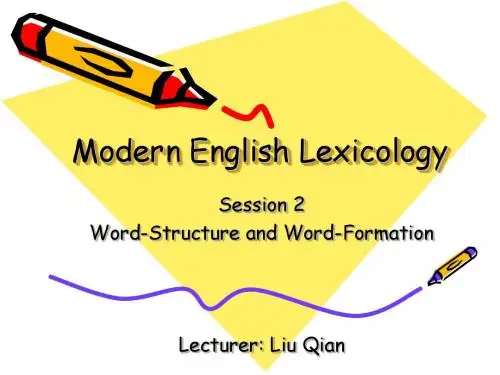
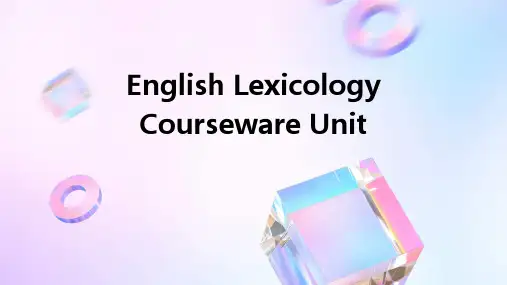
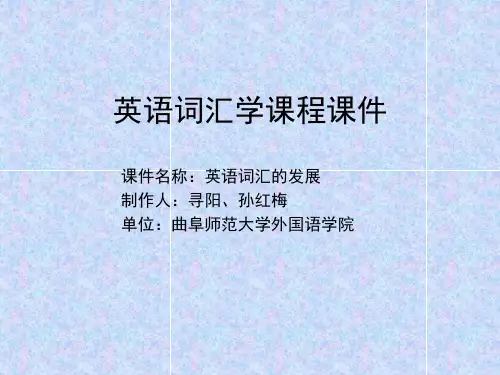
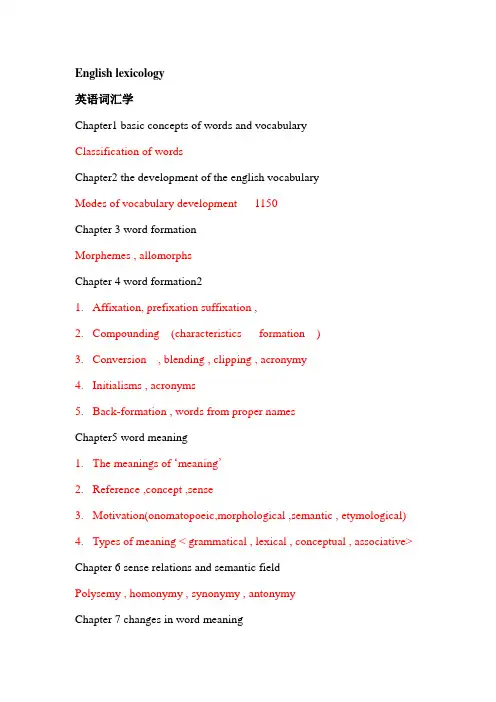
English lexicology英语词汇学Chapter1 basic concepts of words and vocabularyClassification of wordsChapter2 the development of the english vocabularyModes of vocabulary development 1150Chapter 3 word formationMorphemes , allomorphsChapter 4 word formation21.Affixation, prefixation suffixation ,pounding (characteristics formation )3.Conversion , blending , clipping , acronymy4.Initialisms , acronyms5.Back-formation , words from proper namesChapter5 word meaning1.The meanings of ‘meaning’2.Reference ,concept ,sense3.Motivation(onomatopoeic,morphological ,semantic , etymological)4.Types of meaning < grammatical , lexical , conceptual , associative> Chapter 6 sense relations and semantic fieldPolysemy , homonymy , synonymy , antonymyChapter 7 changes in word meaningExtension , narrowing , elevation , degradationChapter 8 meaning and context1.Types of context (extra-linguistic, linguistic)2.Role of contexta.elimination of ambiguityb.indication of referencec.Provision of clues for inferring word-meaningChapter9 english idioms1.Classification of idioms(nominal , adjectival , verbal , adverbial )2.sentence and useChapter 10 english DictionariesTypes of dictionary , three good Dictionarya.Longman dictionary of contemporaryb.Collins COBUILD english Dictionaryc. A Chinese-english DictionaryUnit 1Methods of study ,there are generally two approaches to the study of words ,namely synchronic and diachronicAims and significance of the courseLanguage study involves the study of speech sounds ,grammar and vocabulary .vocabulary has proved particularly important and certainly the most difficult .Willkins asserts ‘without grammar very little can beconveyed ,without vocabulary nothing can be conveyed’ A good knowledge of morphological structure of english words and rules of word-formation will help learners develope their personal vocabulary and consciously increase their word power.V ocabularyAll the words in a language make up its vocabulary .The term vocabulary is used in different senses1.It can refers to the total number of the words in a language2.It can stands for all the words used in a particular historical period3.Also used to all the words of a given dialectClassification of wordsWords may fall into the basic word stock and nonbasic vocabulary by use frequency ,into content words and function words by notion ,and into native words and borrowed words by originBasic word stock have characteristics1.All national character2.Stability3.Productivity4.Polysemy5.Collocability6 Neutral in style7 Frequent in useWords void (lack)of the stated characters ,do not belong to the common core of the language ,they include the following:Terminology 术语,专有名词JargonSlang 俚语,黑话ArgotDialectal wordsArchaismsNeologismsContent words(=notional words) and function words (=empty words) Native words and borrowed wordsApart from the characteristics mentioned of the basic word stock ,in contrast to borrowed words ,native words have two other features Neutral in styleFrequent in useBorrowing words :words taken over from foreign languages are known as borrowed words and loan words or borrowings in simple terms Loan words under four classesDenizens 同化词Aliens 异化词Translation-loans 译借词Semantic-loans 借意词The Indo-European language familyWhich can be grouped into roughly 300 language families on the basis of similarities in their basic word stock and grammar ,theIndo-Europe is one of them .it is thought to be a highly inflected language They accordingly fall into eight principle groups ,which can be grouped into an Eastern set : Balto-slavic, Indo-Iranian, American and Albanian; a Western set; Celtic , Italic, Hellenic,GermanicA historical overview of the english vocabularyThe first people known to inhabit the land were CeltsThe second major language known in England was the Latin of the Roman Legions450- < old > -1150-(Middle)-1500- <modern>-NOWModes of vocabulary developmentWe can concluded that modern english vocabulary develops through three channels < > creation , semantic change , borrowing Creation refers to the formation of new words by using the existing materials namely roots ,affixes and other elementsSemantic change means an old form which takes on a new meaning to meet the new needBorrowing has palyed a vital role in the development ofvocabulary ,particularly in earlier timesMorphemes :minimal meaningful units are known as morphemes,in other words ,the morphemes is ‘the smallest functioning unit in the composition of words ’Chapter 5Word meaningWords are but symbols , many of which have meaning only when they have acquired reference .1.reference is the relationship between language and the word .The reference a word to a thing outside the language is arbitrary <随意的>and conventional <传统的>2.Concept<概念>=notionIn many cases meaning is used in the sense of ‘concept ’meaning and concept are closely connected but not identical3.Sense :generally speaking ,the meaning of ‘meaning’is perhaps what is termed ‘sense’ . ‘sense’denotes the relationships inside the language.Motivation <理据>Motivation accounts for the connection between the linguistic symbol and its meaningOnomatopoeic motivation 拟声的理据<ha ha>Morphological motivation 形态的理据<one can figure out>Semantic motivation 语义<联想>的理据<mouth of river>Semantic motivation refers to the mental associations suggested by the conceptual meaning of a wordEtymological motivation 词源的理据The meaning if many words often related directly to their origins, Types of meaninga.Grammatical meaning an Lexical meaning语法和词汇意义b.Conceptual meaning and associative meaning 概念和联想意义Chapter 6The subjects that have long held the interest and attention ofsemanticists are ,polysemy 多义的, homonymy , synonymy ,antonymy , and hyponymyTwo approaches to polysemyDiachronic approach and synchronic approachThe meanings were acquired by extension ,narrowing ,analogy ,transfer The development of word-meaning from monosemy to polysemy follows two courses,traditionally known as radiation and concatenation Homonymy <different meaning but same sound and spelling>Based on the degree of similarity ,homonyms fall into threeclasses:perfect homonyms ,homographs and homophones1.Perfect homonyms are words identical both in sound and spelling but different meaning .Bank n. The edge of the river ,lakeBank n . An establishment for money businessBear n. A large heavy animalBear v. To put up withDate n. A kind of fruitDate n. A boy or a girl friend2.Homographs are words identical only in spelling but different in sound and meaningBow n. Bending the head as a greetingBow n. The device used for shooting arrowsSow v. To scatter seedsSow n. Female adult pig3.Homophones are words identical only in sound but different in spelling and meaningDear n. A loved personDeer n.a kind of animalRight a. correctWrite v.to put down on paper with a penRite n. Ceremonial procedureSon n. A male child of someoneSun n. The heavenly body from which the earth gets warmth and light Of three types ,homophones constitute the largest number and are most commonOrigins of homonymsChange in sound and spellingBorrowingShortingAs homonyms are identical in sound or spelling ,particularly homophones, they are often employed to create puns<双关>for desired effect of ,say, humor,sarcasm or ridicule<嘲弄>On Sunday they pray for you and on Monday they prey <折磨>on you So-called pious<虔诚的>gentleman and ladies 善男信女The sardonic tone is unmistakable 讽刺的语气是不言而喻的SynonymySynonymy is one of the characteristic features of vocabulary of natural languagesTypes of synonyms1. Absolute synonyms also known as complete synonyms are words which are identical in meaning in all its aspects,both in grammatical meaning and lexical meaning ,including conceptual and associative meanings2. Relative synonymy also called near-synonyms are similar or nearly the same in denotation,but embrace different shades of meaning or different degrees of given quality.For example .to change a thing is to put another thing in its place ;to altera thing is to alter it in different manner and at different times .’A man change his habits ,alters his conduct ,and varies his manner of speaking’Look at stagger /reel/totter.stagger implies unsteady movement characters by a loss of balance and failure to maintain a fixed course . Stagger under a heavy load ;reel suggests a swaying or lurching so as to appear on the verge of falling .Silent沉默的,无言的,寂静的/ tacit , shine闪耀,发光/ glitter华丽夺目,炫耀/sparkle闪耀,活跃,焕发活力和才智/glare强光,瞪眼,炫耀, different/ various, idle空闲的,懒惰的,无意义的/lazy/indolent , strange奇怪的/odd 古怪的/ queer,古怪的,可疑的large / huge庞大的/tremendous极大的,巨大的,惊人的,极好的/colossal Sources of synonyms1.BorrowingAs a result of the borrowing ,words of native origin form many couplets and triplets with those from other language2.Dialects and regional english3.Figurative an euphemistic4.Coincidence with idiomatic expressionsDiscrimination of synonymsThe differences between synonyms boil down to three areas: denotation , connotation ,and application1.Difference in denotation .‘I did not comprehend his arguments ,although i understood the language , and all the sentences’A lump of sugar一块糖, a slice of meat一片肉, a chunk of wood , a sheet of paper A cake of soapTypes of antonyms1.Contradictory termsThe assertion of one is the denial of the otherAnother distinctive feature of this category <类型>is that such antonyms are non-gradable2.Contrary terms3.Relative termsHolds water <站得住脚的>Characters of antonyms1.Antonyms are classified on the basis of semantic opposition.words denoting nature, quality or state of things have many antonyms2.A word which has more than one meaning can have more than one antonym3.Antonyms differ in semantic inclusion .pairs of antonyms are seen as marked and unmarked terms respectively4.Contrary terms are gradable antonymsDestitute / opulent dull / livelyHyponymyHyponymy deals with the relationship of semantic inclusion.That is the meaning of more specific word word is included in that of another more general word .For instance ,tulip and rose are hyponyms of flowerSuperordinate termsHammer , saw , screwdriver ,spanner, plaice, cod , herring ,sole Semantic field <领域>The massive word store of a language like english an be conceived of as composed around a number of meaning areas.An integrated system of lexemes interrelated in sense 语义相互关联It is general belief that.....Personal address system 个人称呼KinshipTypes of changesWord-meaning changes by modes ofExtension< 扩展>,narrowing<缩小> ,degradation< 降格>,elevation< 升格>,and transferCauses of changes: it is in response to some needExtra-linguistic factors1.Historical reason2.Class reason3.Psychological 心理学的,精神上的reasonThe role of context <语境>1.Elimination of ambiguity <消除歧义>2.Indication of referents <限定所指>3.Provision of clues for inferring word -meaning <为猜测词义提供线索>①Definition②Explanation③Example④Synonymy⑤Antonymy⑥Hyponymy⑦Relevant details⑧Word structureChapter 9Idioms consists of set phrases and short sentences ,which are peculiar to the language in question and loaded with the native cultures and ideas .therefore, idioms are colorful ,forcible and thought-provoking.For example ,fly off the handle (become excessively angry) and put up with ( tolerate)In a board sense ,idioms may included colloquialisms ,slang experience, proverbs .Character of Idioms1.Semantic unityBeing phases or sentences ,idioms each consist of more than one word ,but each is a semantic unity. Idiom have their respective literal meanings .for instance, till the cows come homeKeep in mind <remember> take off <imitate模仿>to no avail <useless> like a breeze <easily>2.Structural stability 结构稳定First the constituents of idioms cannot be replacedLip service <support only in words ,not in fact > is not to be changed into mouth service . Kick the bucket <die> bury the hatchet <come to friendly or peaceful terms>Secondly ,the word order cannot be inverted or changed ,for example ,by twos and threes and tit for tat are not to be turned into by threes and twos and tat for titThe lion share is ....最大的,份额Thirdly,the constituents of an idioms cannot be deleted or added too . Not even an articleFinally many idioms are grammatically unanalysable for exampel ,diamond cut diamond <two parties are equally matched > Sure as eggs is eggs <quite certainly>It should be pointed out that the idiomaticity of idioms is gradableand may best be thought in terms of a scaleHis promotion stepped up <improve or enhance>The boy playing in the river in the raw <naked>Turn over a new leaf <begin a new life>, as cool as a cucumber泰然自若draw the certain <end or conceal>Idioms nominal in natureIdioms of this class have a noun as the key word in each and function as a noun in sentencesWhite elephant<a+n>something useless and unwanted but big and costly 华而不实的东西Pink elephantThe Elephant in the roomBrain trust <n+n>智囊团An appel of discord <n+prep+n>祸根Jack of all trades<n+prep+det+n>万事通,三脚猫Fly in the ointment<n+prep+n>something that spoils the perfection of somethingFlesh and blood 亲情Idioms adjective in natureCut and dried <a+a>already settled and unlikely to be changedAs poor as a church mouse<as+a+as+n>having ,orearning ,barely enough money for one’s needsWide of the mark <not at all suitable ,correct>Beyond the pale <beyond the limit of proper behaviour> Up in the air <uncertain>Idioms verbal in natureThis is the largest group of all .subdivided into phrasal verbs短语动词and other verb phrases动词短语Look into <investigate>调查,研究go on <continue>Put off <discourage ...from ; cause....to ;dislike .Delay .make excuses in order to avoid a duty>Turn on 兴趣盎然get away with <get something wrong without being punished>Put down to 把.....归因于Mak it 赶上了follow one’s nose 朝相同地方走Fall flat <fail completely in its intended or expected effect> Give sb the bag 炒鱿鱼Sing a different tune <change one’s opinion or attitude> Call it a day <decide or agree to stop either temporary or for good>Chop and change 变化无常Swim against the stream 不随波逐流Come back to earth 脚踏实地Make ends meet 收支平衡Keep the pot boiling 量入为出,维持生计Let the dog see the rabbit 好狗不挡道Bite the hand that feeds one恩将仇报Tooth and nail 全力以赴Through thick and thin 同舟共济In clover or in the clover 生活安逸Sentence idiomsThey are mainly proverbs and sayings ,including colloquialisms and catchphrase ,as far as sentence types are concerned,they embracedeclarative ,interrogative , imperative, and exclamative sentences. In terms of complexity they can be further divided into simple compound and complex sentenceNever do things by halves 不要半途而废That’s the time of day <exclamative,simple>Let the sleeping dog die 别多管闲事A leopard cannot change its spotsBehind the mountains there are people to be found Upon my word 正如所言,的确Art is long , life is short ,生命短暂,艺术无涯Pepper and salt 花白的头发Bag and baggage 所有家当High and low 高低贵贱Use of idiomsWe need aware of the rhetoric characteristics of idioms such as stylistic , features , rhetoric features and their occasional variationsIn deep water 陷入困境,tide over克服Take the helm 掌权If you run after two hares , you will catch neither 脚踩两只船Have all one’s eggs in one basket 孤注一掷New brooms sweep clean 新官上任三把火Wash one’s dirty linen in public 家丑不可外扬Keep the pot boiling 维持生计Boil down 压缩Jump the bait 上钩了Hit below the belt 玩阴的play fair 公平竞争Come to pass <take place ,happen >Be it that <even though >即使,尽管In the wake of <right after, following>紧接着Give the lie to <all sb a lair >称某人是骗子Of note <notable , well-know>著名的Mishandle, mess up , 搞砸了Variations of idioms1.Replacement2.Addition or deletion3.Position-shifting4.Shortening5.Dismembering。
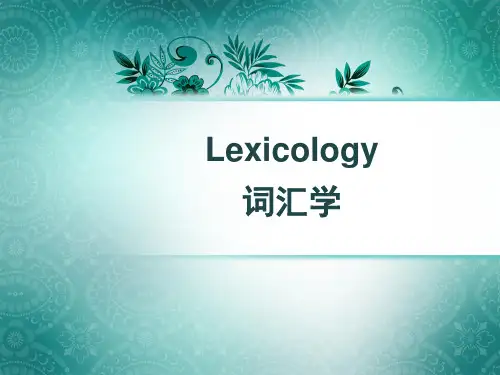
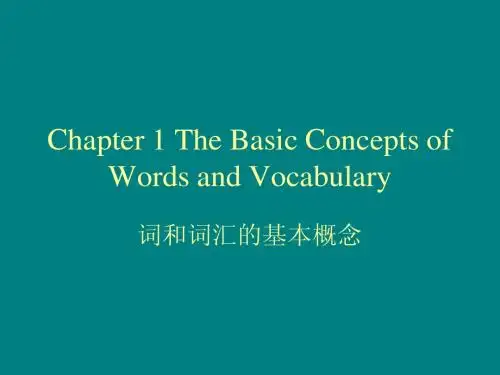
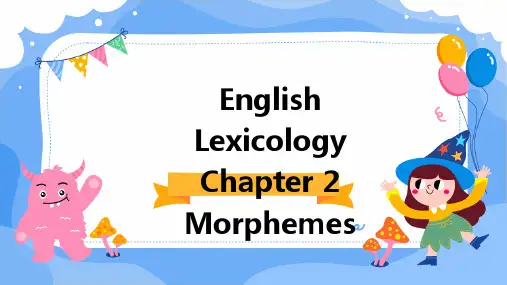
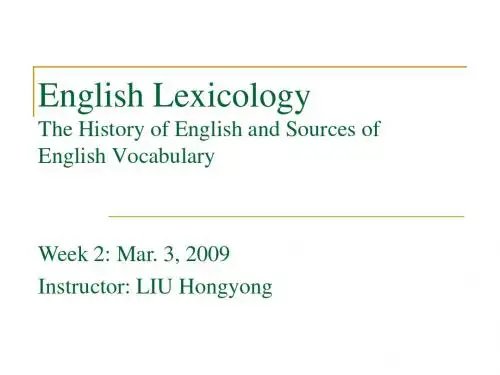
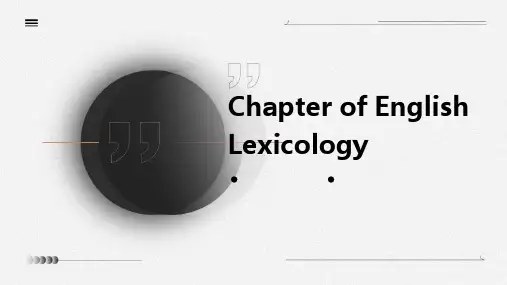

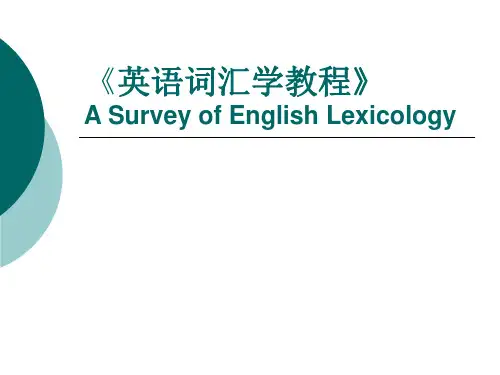
英语词汇学English Lexicology English LexicologyClass: 1104Number:Name:American EnglishI. The Growth of American English th A. From the 17 century to the end of The War of Independence1. The setting of Jamestown (in 1607)2. The setting of Virginia(in 1609)3. The second internal settlement in Plymouth - by "the May Flower".4. By 1732,the English has set up 13 colonies and then English became theircommon language.5. In 1756,the word "American Dialect"was firstly proposed.6. In 1783,the book The American Spelling Book ,advocating the independence of the American English.B. From The War of Independence to The Civil War1. Because of the immigration more and more people began to speak English.2. In the book An American Dictionary of the English Language, the writer told people the characteristic of the spelling of American English. C. After The Civil WarAmerica became the "main country"of the western country. II. Characteristics of American EnglishA. 美国英语的一致性作为美国唯一的官方语言和多民族通用语言,美国英语具有惊人的一致性。
Lectures on English LexicologyMain Sections for the Lectures:Chapter 1: Basic Concepts of Words and Vocabulary1.1What Is a Word?A word is a minimal free form of a language that has a given sound and meaning and syntactic function.1.2 Sound and MeaningA word is a symbol that stands for something else in the world. This symbolic connection is almost always arbitrary, and there is no logical relationship between the sound which stands for a thing or an idea and the actual thing and idea itself. The relationship between sound and meaning is conventional because people of the same speech community have agreed to refer to a certain thing with a cluster of sounds. In different languages the same concept can be represented by different sounds.1.3 Sound and FormIt is generally agreed that the written form of a natural language is the written record of the oral form. The English alphabet was adopted from the Romans.In spite of the differences, at least eighty percent of the English words fit consistent spelling patterns.1.4 V ocabularyAll the words in a language make up its vocabulary.The general estimate of the present-day English vocabulary is over one million words.1.5 Classification of Words1.5.1 Basic Word Stock and Non-basic V ocabularyBasic words have the following characteristics:1.All national character: they denote the most common things and phenomena ofthe world around us, which are indispensable to all the people who speak the language.2.Stability: as these words denote the commonest things necessary to life, they arelikely to remain unchanged.3.Productivity:as they are mostly root words or monosyllabic words, they caneach be used alone, and at the same time can form new words with other roots and affixes4.Polysemy:words of this kind often possess more than one meaning becausemost of them have undergone semantic changes in the course of use and become polysemous.5.Collocability: most of these words enter quite a number of set expressions,idiomatic usages, and proverbial sayings.“All national character” is the most important of all features that may differentiate words of common use from all others.Non-basic words include the following:1.Terminology(术语): technical terms used in particular disciplines andacademic areas.2.Jargon(行话): the specialized vocabularies by which members of particular arts,sciences, trades and professions communicate among themselves.3.Slang(俚语)4.Argot(黑话)5.Dialectal words(方言词语)6.Archaisms(古语)7.Neologisms(新词)1.5.2 Content Words and Functional WordsContent words denote clear notions and thus are known as notional words(实义词). They include nouns, verbs, adjectives, adverbs and numerals, which denote objects, phenomena, action, quality, state, degree, quantity, etc.Functional words do not have notions of their own. They are also called empty words. The chief function of these words is to express the relation between notions, the relation between words as well as between sentences. They are known as form words. Prepositions, conjunctions, auxiliaries and articles belong to this category.Content words are numerous and the number is ever growing whereas the functional words which make up a small number of vocabulary,remain stable. However, functional words do far more work of expression in English on average than content words.1.5.3 Native Words and Borrowed WordsNative words: words brought to Britain in the 5th century by the Germanic tribes: the Angles, the Saxons, and Jutes, thus known as Anglo-Saxon words. Words of Anglo-Saxon origin are small in number, amounting to roughly 50,000 to 60,000, but they form the mainstream of the basic word stock and stand at the core of the language.Native words have two other features:1.Neutral in style: since native words denote the commonest things in humansociety, they are used by all people, in all places, on all occasions, and at all times.Stylistically, native words are neither formal nor informal whereas the words borrowed from French or Latin are literary and learned, thus appropriate in formal style.2.Frequent in use: Native words are most frequently used in everyday speech andwriting. The percentage of native words in use runs usually as high as 70 to 90 percent.Borrowed word: words taken over from foreign languages are known as borrowed words or loan words or borrowings in simple terms. It is estimated that English borrowings constitute 80 percent of the modern English vocabulary.The loan words can be classified into four classes:1.Denizens(同化词)are words borrowed early in the past and now are wellassimilated into the English language. eg: pork----porc(F) cup---cuppa(L) 2.Aliens(非同化词)are borrowed words which have retained their originalpronunciation and spelling. eg: bazzar (per) intermesso( IT)3.Translation loans(译借词)4.Semantic loans(语义借词)Questions and Tasks on P20: 1—6Chapter 2: The Development of the English Vocabulary The English language is not the language of the early inhabitants of the British Isles.A Historical Overview of the English vocabularyThe first peoples known to inhabit the land were Celts. Their languages were dialects of still another branch of the Indo-European language family—Celtic(克尔特语).The second major language known in England was the Latin of the Roman Legions. In 55-54 B.C., the Romans invaded the British Isles and were to occupy the land until about 410.When the Roman empire began to crumble, the Germanic tribes came in. they are Angles, Saxons, and Jutes.2.2.1 Old English (450—1150)The Germanic tribes took permanent control of the land, which was to be called England (the land of Angles). Their language, historically known as Anglo-Saxon, dominated and almost totally blotted out the Celtic. People generally refer to Anglo-Saxon as Old English. Old English has a vocabulary of about 50,000 to 60,000 words. It was a highly inflected language just like modern German.2.2.2 Middle English (1150--1500)Old English began to undergo a great change when the Normans invaded England from France in 1066. the Norman Conquest started a continual flow of French words into English. Between 1250 and 1500 about 9,000 words of French origin poured into English. 75 percent of them are still in use today.2.2.3 Modern English (1500—up to now)Modern English began with the establishment of printing in England. In the early period of Modern English, Europe saw a new upsurge of learning ancient Greek and Roman classics. This is known in history as the Renaissance.In the mid-seventeenth century, England experienced the Bourgeois Revolution followed by the Industrial Revolution and rose to be a great economic power.Although borrowing remained an important channel of vocabulary expansion, yet more words are created by means of word-formation.Growth of Present-day English V ocabularyGenerally, there are three main sources of new words: the rapid development of modern science and technology; social, economic and political changes; the influence of other cultures and languages.Modes of V ocabulary DevelopmentModern English vocabulary develops through three channels: creation, semantic change, borrowing.1.Creation refers to the formation of new words by using the existing materials,namely roots, affixes and other elements. In modern times, creation is the most important way of vocabulary expansion.2.Semantic change means an old form which takes on a new meaning to meet thenew need.3.Borrowing has played a vital role in the development of vocabulary, particularlyin earlier times.Questions and Tasks on P33: 3, 4, 10Chapter 3: Word Formation IThough borrowing has been playing an active role in the expansion of vocabulary, vocabulary is largely enriched on an internal basis.boys boy+schecking check+ingchairman chair+manMorphemes(词素)the smallest meaningful unit of language Morpheme is the smallest unit of language in terms of relationship between expression and content, a unit that cannot be divided into further smaller units without destroying or drastically altering the meaning, whether it is lexical or grammatical, e.g. boys---boy+-s indicates pluralitychecking---check+-ingdisappointment词是由一个或一个以上的词素构成的。